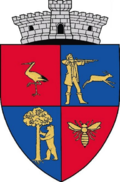Moșnița Nouă
|
Moșnița Nouă Neumoschnitza Újmosnica, Mosnicapuszta |
||||
|
||||
| Basic data | ||||
|---|---|---|---|---|
| State : |
|
|||
| Historical region : | Banat | |||
| Circle : | Timiș | |||
| Coordinates : | 45 ° 43 ' N , 21 ° 20' E | |||
| Time zone : | EET ( UTC +2) | |||
| Area : | 5.12 km² | |||
| Residents : | 6,203 (October 20, 2011) | |||
| Population density : | 1,212 inhabitants per km² | |||
| Postal code : | 307285 | |||
| Telephone code : | (+40) 02 56 | |||
| License plate : | TM | |||
| Structure and administration (as of 2016) | ||||
| Community type : | local community | |||
| Structure : | Albina , Moșnița Veche , Rudicica , Urseni | |||
| Mayor : | Bucur Florin-Octavian ( PNL ) | |||
| Postal address : | Strada Principală, no. 73 loc. Moșnița Nouă, jud. Timiș, RO-307285 |
|||
| Website : | ||||
Moșnița Nouă [ 'moʃnitsa' nouə ] ( German Neumoschnitza , Hungarian Újmosnica , Mosnicapuszta ) is a municipality in the Timiș County , in the Banat region , in southwest Romania . The villages of Albina , Moșnița Veche , Rudicica and Urseni belong to the municipality of Moșnița Nouă .
Geographical location
Moșnița Nouă is located on the DJ 592 Timișoara - Buziaș county road , about eight kilometers from the center of Timișoara. As a result of the new development areas that have arisen around Timișoara in the last two decades, the dividing line between the municipality and the district capital has been greatly reduced.
The other villages of the municipality Moșnița Nouă are not far from the community center: Moșnița Veche is 1.8 kilometers north, Urseni 3 kilometers south, Albina 3 kilometers east and Rudicica in the southwest of Moșnița Nouă. The expansion of the villages has led to a reduction in the distance between the localities. The distance between the nearest building from Moșnița Nouă and Moșnița Veche is less than 250 meters.
Neighboring places
| Plopi | Ghiroda Noua | Moșnița Veche |
| Ciarda Roșie |

|
Albina |
| Giroc | Urseni | Uliuc |
history
The village of Újmosnica was founded in 1902 with Hungarians from Békés and Szentes counties . For this purpose, the existing forests were cleared. Over time, the economic importance of the village grew, so that Újmosnica was raised to the community center of the surrounding villages.
After the Treaty of Trianon , when a large part of the Banat Romania was awarded, the place received the official name Moșnița Nouă . In the parlance of the German population the place was called Neumoschnitza .
Demographics
The population of the municipality developed as follows:
| census | Ethnicity | |||||||
|---|---|---|---|---|---|---|---|---|
| year | Residents | Romanians | Hungary | German | Other | |||
| 1880 | 1901 | 1369 | 324 | 192 | 16 | |||
| 1930 | 4333 | 1987 | 2007 | 251 | 88 | |||
| 1977 | 4784 | 3535 | 1156 | 43 | 50 | |||
| 1992 | 3941 | 3201 | 661 | 20th | 59 | |||
| 2002 | 4298 | 3530 | 598 | 20th | 150 | |||
| 2011 | 6203 | 5097 | 545 | 17th | 544 | |||
Web links
Individual evidence
- ↑ a b 2011 census in Romania ( MS Excel ; 1.3 MB)
- ↑ Mayoral elections 2016 in Romania ( MS Excel ; 256 kB)
- ↑ a b mosnitanoua.ro ( Memento from December 18, 2014 in the Internet Archive ) Primăria Moșnița Nouă
- ↑ cjtimis.ro , Consiliul immerean Timiș, Comuna Moșnița Nouă
- ↑ E. Varga: Statistics of the population by ethnicity in the Timiș district according to censuses from 1880–2002 (Hungarian; PDF; 982 kB)




